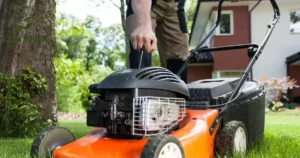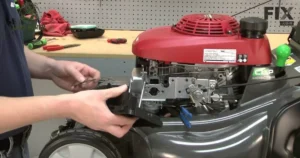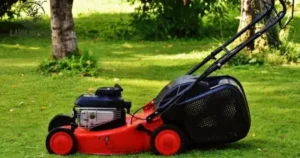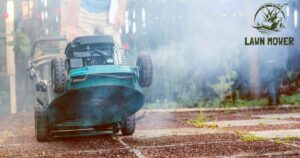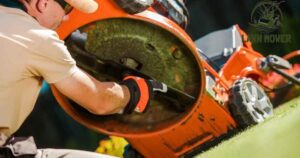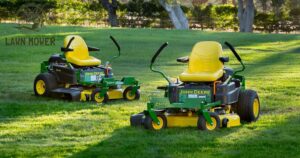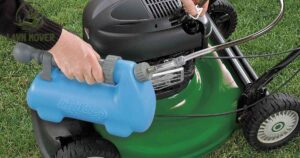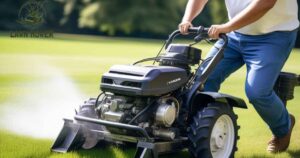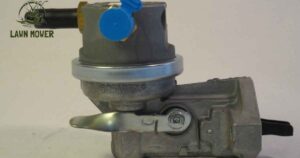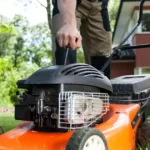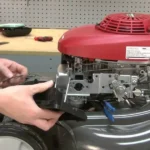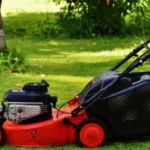Cutting wet grass with a lawn mower is not recommended as it can result in uneven and messy cuts. Wet grass tends to clump together, clogging the mower and hindering its performance. It’s best to mow when the grass is dry for a cleaner and more effective lawn care experience.
Wondering if it’s feasible to tackle your lawn while it’s still damp? The burning question on every gardener’s mind is, “Can you cut wet grass with a lawn mower?” Discover the ins and outs of mowing soggy lawns and whether your trusty mower can handle the challenge.
Mowing wet grass with a lawn mower is not recommended as it can result in an uneven and messy trim. Wet grass tends to clump together, clogging the mower deck and impeding proper cutting. Additionally, using mixed gas in a lawn mower may exacerbate these issues and affect the overall performance. Therefore, it’s advisable to mow when the grass is dry to achieve a cleaner and more effective lawn maintenance.
Can you cut grass when it’s wet?
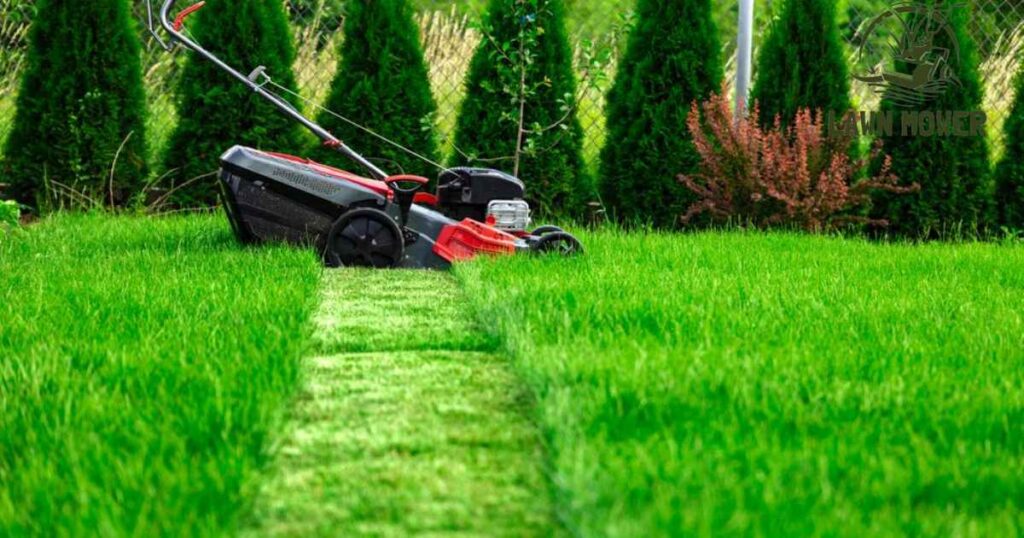
Cutting grass when it’s wet is generally not recommended. Wet grass tends to clump together, making it difficult for the lawnmower to cut evenly. The moisture also creates a sticky environment, which can clog the mower and lead to a less effective cutting process.
Moreover, cutting wet grass can contribute to the spread of fungal diseases, as the blades of grass may tear rather than being cleanly cut. It’s advisable to mow the lawn when the grass is dry to ensure a neater cut, maintain the health of the lawn, and avoid potential damage to the lawnmower.
How to cut grass in the rain (how to cut wet grass).
Cutting grass in the rain requires some adjustments for a successful mow. First, choose the right equipment—opt for a sharp blade and ensure the mower is in good condition. Wet grass can clump, so mow at a higher setting to prevent clogging and achieve a more even cut.
Timing is crucial; aim to mow when the rain is light, and the grass is not overly saturated. Additionally, consider leaving the grass clippings on the lawn as they can break down and nourish the soil. By following these tips, you can maintain your lawn even when the weather doesn’t cooperate.
Don’t use a heavy mower.
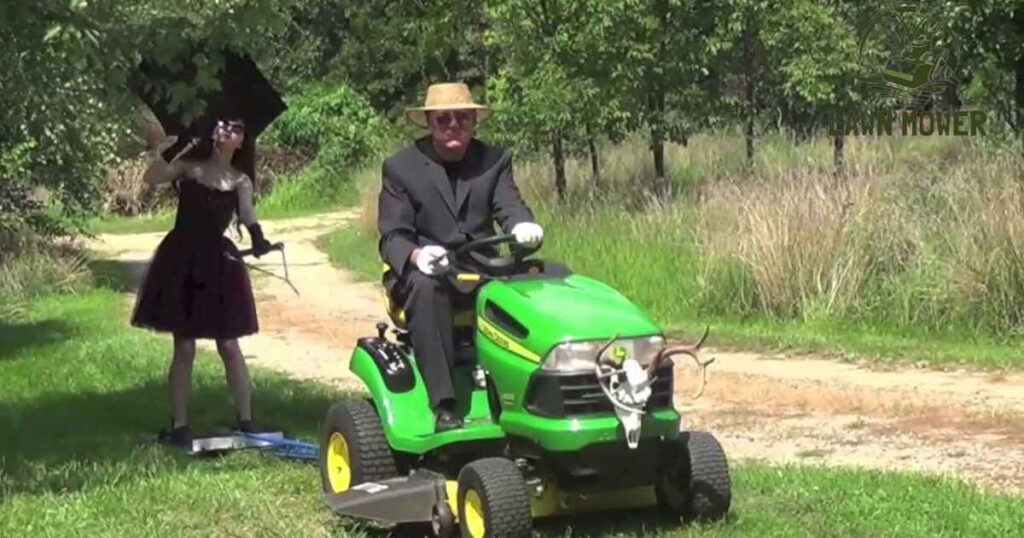
When caring for your lawn, it’s crucial to be mindful of the equipment you use, especially when dealing with wet grass with a lawn mower. Opting for a heavy mower can lead to unintended consequences, such as soil compaction and damage to your grass. Lighter mowers are often more agile and gentle on your lawn, preventing unnecessary stress on the soil and plants.
Using a heavy mower on wet grass with a lawn mower can result in clumping and uneven cutting. The excess weight of the mower may cause soil compaction, hindering the growth of your grass. Choosing a lighter alternative ensures a more delicate touch, promoting healthier grass and an overall more vibrant lawn.
Don’t use a roller mower
When it comes to maintaining your lawn, it’s crucial to avoid using a roller mower, especially when dealing with wet grass. Rolling mowers can lead to compacted soil and hinder the healthy growth of your lawn. The weight and pressure exerted by a roller mower on wet grass can create an unfavorable environment, potentially causing damage to the turf and promoting the development of diseases.
Mowing wet grass with a lawn mower is generally discouraged as it can result in uneven cuts and clumping, leading to an unkempt appearance. The moisture on the grass blades makes them stick together, causing the mower to struggle and leaving behind an untidy finish. To ensure a well-maintained and thriving lawn, it’s advisable to wait for the grass to dry before using any mower, preventing potential harm to both the grass and the overall health of your lawn.
Use a purpose-made mower
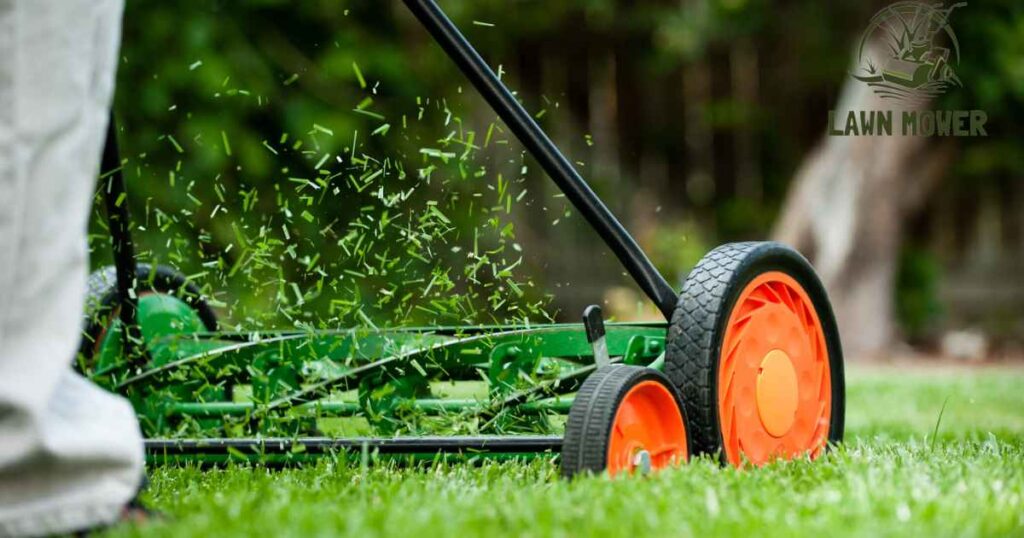
When tackling your lawn care, it’s essential to use a purpose-made mower designed for the task. These specialized machines are equipped with features tailored to efficiently cut grass, ensuring a cleaner and more manicured appearance for your lawn. A purpose-made mower not only saves you time but also helps maintain the health of your grass by providing a precise and even cut.
However, it’s crucial to exercise caution when dealing with wet grass with a lawn mower. Using a purpose-made mower on wet grass can lead to clumping and uneven cuts, potentially damaging the turf. Wet conditions increase the likelihood of clogging the mower deck, making it less effective in achieving the desired results. To ensure optimal performance and preserve the health of your lawn, it’s advisable to mow when the grass is dry, allowing the purpose-made mower to operate at its best.
Use a mower with a hard-sided collector
Using a mower with a hard-sided collector is crucial, especially when dealing with wet grass with a lawn mower. The hard-sided collector efficiently gathers clippings, preventing them from sticking to the mower or clogging the blades. This not only ensures a smoother mowing experience but also contributes to a healthier lawn by promoting proper grass growth.
When mowing wet grass with a lawn mower, the hard-sided collector becomes even more beneficial. It helps prevent the accumulation of wet clumps on the lawn, reducing the risk of fungal diseases and creating a neater appearance. Additionally, the collector simplifies the cleanup process, making it easier to dispose of the grass clippings without leaving a mess on your freshly cut lawn.
Grass stains on paving
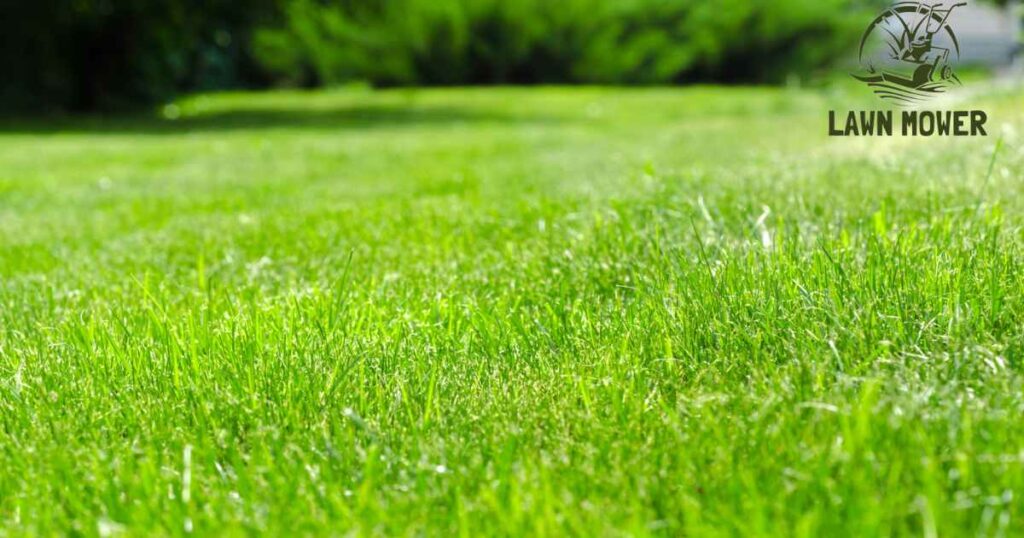
Wet grass clippings from a freshly mowed lawn can often leave stubborn stains on paved surfaces. The vibrant green hues of the wet grass, mixed with the residue from a lawn mower, create distinctive patterns on the pavement. These grass stains not only add a touch of nature to the concrete landscape but also serve as a reminder of the outdoor chores and the effort put into maintaining a well-kept lawn.
As the lawn mower moves across the wet grass, it inadvertently transfers the moisture and pigments onto the paving below. The result is an artistic imprint of the mowing process, showcasing the interaction between man-made tools and the natural elements. While some may see these stains as an unintended consequence, others appreciate the unique charm they bring to outdoor spaces, turning mundane concrete into a canvas that reflects the beauty of a freshly trimmed lawn.
Is it safe to cut wet grass with a cordless electric mower?
- Lawn mower design: Cordless electric mowers are generally designed to be safe for use on wet grass. The electrical components are well-insulated, minimizing the risk of electric shock.
- Safety features: Many cordless electric mowers come with safety features such as moisture-resistant components and sealed electrical systems, ensuring safer operation even in damp conditions.
- Battery safety: Cordless mowers typically operate on rechargeable batteries, eliminating the risk of electric shock associated with corded mowers. This makes them inherently safer for use on wet grass.
- Reduced slip hazards: Cordless electric mowers often have better traction, reducing the likelihood of slips and falls when mowing wet grass compared to traditional gas mowers.
- Consult manufacturer guidelines: While cordless electric mowers are generally safe for wet grass, it’s essential to consult the manufacturer’s guidelines for specific recommendations and precautions to ensure safe operation in varying conditions.
Does wet grass dull mower blades?
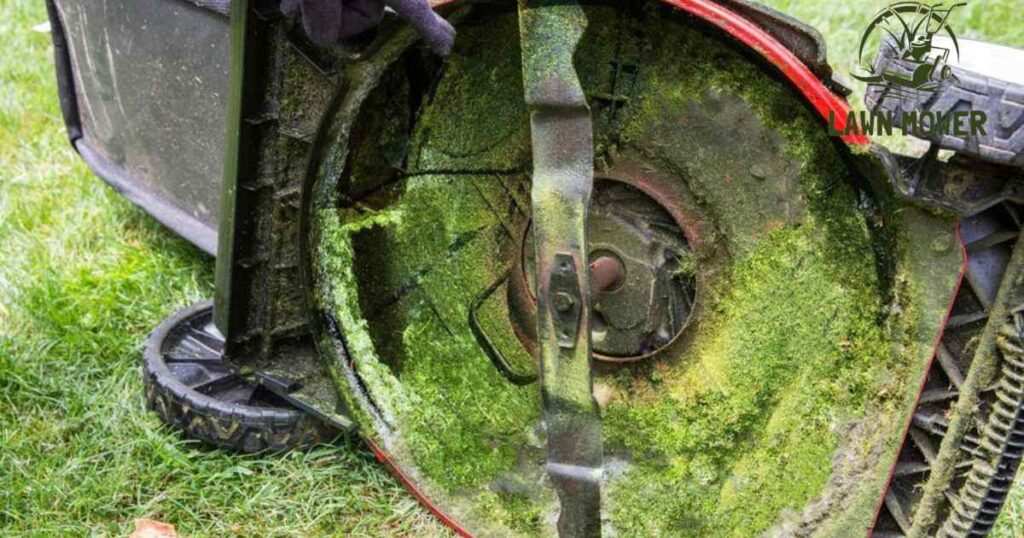
Mowing wet grass with a lawn mower can have an impact on the sharpness of the blades. When grass is damp, it tends to clump together and create a heavier load on the mower blades. This extra resistance can result in more friction and wear on the blades, potentially leading to dullness over time.
Regular maintenance, including sharpening the blades, becomes crucial when mowing wet grass with a lawn mower. Dull blades not only make the mowing process less efficient but also contribute to an uneven lawn cut. To prolong the life of your mower blades and ensure a pristine lawn, it’s advisable to wait for the grass to dry before mowing or to clean and sharpen the blades more frequently if mowing in wet conditions is unavoidable.
Does cutting wet grass hurt the mower?
Cutting wet grass with a lawn mower can potentially harm the machine. When grass is wet, it becomes heavier and clumps together, making it more challenging for the mower to efficiently cut through. The added moisture can also lead to clogging of the mower deck, reducing its overall performance.
Moreover, wet grass poses a safety risk as it can make the ground slippery, increasing the likelihood of accidents. Additionally, the wet clippings left behind may accumulate on the mower, forming a layer that hampers proper airflow and cooling, potentially causing overheating issues. In summary, it is generally advisable to wait until the grass is dry before mowing to ensure both the longevity of the mower and a safer mowing experience.
What to do if the grass is too wet?
| Situation | What to Do |
| Wet Grass After Rain | 1. Wait for it to dry: Avoid walking on wet grass to prevent compaction. Wait until the grass has dried before mowing or engaging in activities on the lawn. 2. Mow when dry: If you must mow, wait for the grass to dry completely to prevent clumping and damage to the lawn. |
| Waterlogged Lawn | 1. Improve drainage: Address underlying drainage issues to prevent waterlogging. 2. Aerate the soil: Use a lawn aerator to improve soil aeration and water infiltration. 3. Add organic matter: Incorporate compost to enhance soil structure and drainage. |
| Dewy Grass in the Morning | 1. Delay mowing: If the grass is covered in dew in the morning, it’s better to delay mowing until the grass dries out later in the day. 2. Choose the right time: Aim to mow when the grass is dry to achieve a clean and even cut. |
| High Humidity | 1. Mow during dry periods: Schedule lawn maintenance activities during periods of lower humidity to avoid excessive moisture on the grass. 2. Use sharp blades: Sharp mower blades cut more cleanly, reducing the likelihood of disease in humid conditions. |
| After Watering | 1. Water in the morning: Watering in the morning allows the grass to dry throughout the day, reducing the risk of disease. 2. Adjust watering frequency: Avoid overwatering, as excessively wet soil can lead to waterlogged conditions. |
| Prevention Tips | 1. Choose the right grass type: Select grass varieties that are well-suited to your climate and soil conditions. 2. Maintain proper lawn height: Keep your grass at the recommended height to promote air circulation and reduce moisture retention. |
FAQs
Is it safe to cut wet grass with an electric mower?
Cutting wet grass with an electric mower is unsafe due to the heightened risk of slips, electric shock, and potential damage to the mower. Wet grass clumping can also hinder the cutting process, impacting the mower’s performance.
Will mowing wet grass ruin lawn mower?
Mowing wet grass can potentially damage a lawn mower as the moisture makes the grass heavier and can clog the mower deck. Additionally, wet conditions increase the risk of slipping and accidents during mowing.
Can I cut the grass with a lawn mower if it’s wet?
It’s generally not recommended to cut wet grass with a lawn mower as it can result in an uneven cut and potentially harm the mower. Wet grass tends to clump and may clog the mower, impacting its performance.
Conclusion
Cutting wet grass with a lawn mower is generally not recommended. Wet grass tends to clump together, making it challenging for the mower to cut evenly and leaving behind unsightly clumps on the lawn. Moreover, mowing wet grass can strain the mower’s engine and lead to potential damage, as the wet conditions may cause the grass to stick to the blades or clog the discharge chute.
To maintain a healthy and well-groomed lawn, it is advisable to wait until the grass is dry before using a lawn mower, ensuring a more effective and efficient cutting process.While some modern mowers come equipped with features to handle damp conditions, it is still essential to exercise caution and consider the potential drawbacks of mowing wet grass.
Waiting for the lawn to dry or choosing the right time to mow can contribute to a better overall lawn care experience, preserving both the condition of the mower and the aesthetics of the grass.

With a wealth of expertise spanning six years, I am a seasoned professional in the realm of lawn mowers. My mastery includes intricate knowledge of models, maintenance, and optimal performance.

